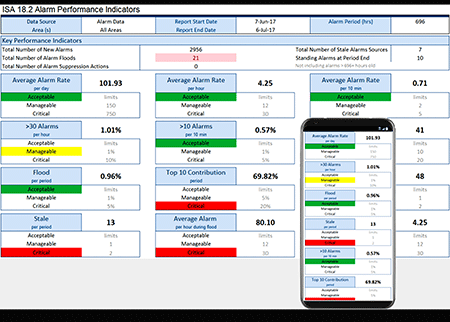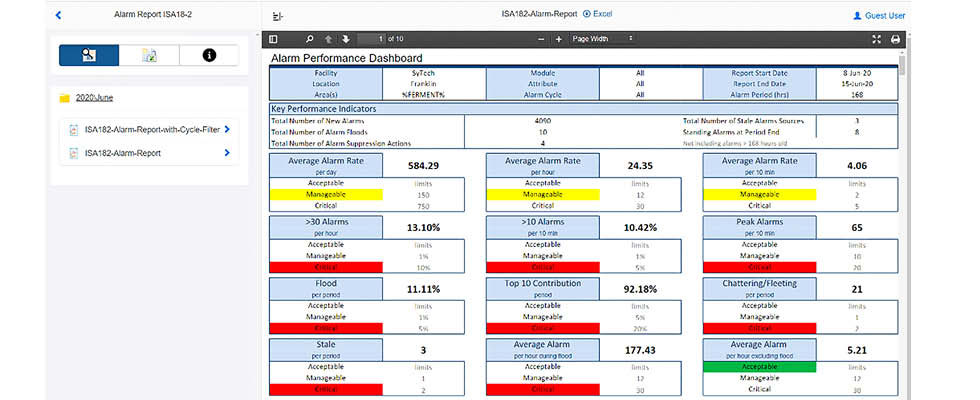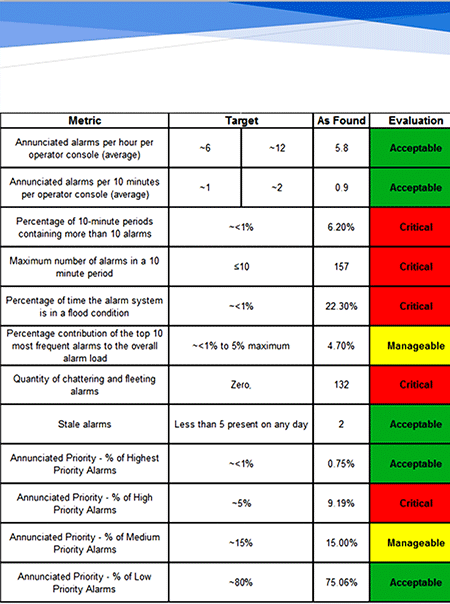
While digital transformation and industrial Internet of Things (IIoT) may just seem like trending buzz words, the technologies are critical to reducing unplanned downtime and ensuring operations are efficient and competitive. Every industry strives for maximum efficiency, be it manufacturing, oil and gas or water/wastewater. For advanced operations autonomously capturing production data, the days of the clipboard and manual data analysis are gone.
Digital technology and interconnectivity are driving technologies like advanced computing solutions; cloud and remote computing; IoT and connected devices; smart and real-time data sensors; data capture, software analytics and processing; and the adoption of artificial intelligence (AI) and machine learning. To remain competitive—particularly in light of worker shortages—and increase productivity, Industry 4.0 and complementary technology must be embraced.

IMAGE 1: Any improvements to an alarm system start by identifying problem areas. Third-party reporting software can provide filters that help reveal the unknown challenges. (Images courtesy of SmartSights)
Operations & Technology
The ultimate goal of adopting modern systems is to have a wholly efficient, possibly even autonomous process that cuts out excess fat, ballooning costs and wasteful operations. Focus should be on end-to-end process improvement, which will, in turn, help shape collaboration within the organization. That means investing in training and education, process automation, related hardware and new tools or software. Continuous operational improvement starts with capturing data from machine assets. This data provides immediate insights for both systems and people, driving automation and enabling better, faster decision making.
Let’s take an example of a smart manufacturing plant using data. Characterized by increasing automation and the employment of smart machines and smart factories, informed data helps to produce goods more productively
across the value chain. By collecting additional data from the factory floor and combining that with other enterprise operational data, a smart factory can achieve information transparency and make better decisions. Accurate, real-time production data is pivotal to shop floor operations and the effective operation of each machine asset.
Once real-time process information is gathered, the next logical step is to define conditions of concern on those process variables. For example, is an oven too hot or a motor spinning too slowly? Is a tank nearing empty or a pressure too high? Are there issues with the centrifugal pumps drawing liquid? Supervisory control and data acquisition (SCADA) systems provide for such conditions to be defined and tracked, monitoring process variables and surfacing active conditions to human machine interfaces (HMI). These condition-based events and alarms add another level to optimizing the process.
Remote Alarm Notification Software
A key theme of Industry 4.0 and smart operations is greater connectivity—increasing connectivity between devices, industrial networks, physical assets and the cloud. Growing connectivity allows for greater process transparency and the added potential for predictive analytics and sentinel alarm conditions. Smart manufacturing allows potential issues to be addressed before they become problems, but only by extending that connectivity to the people who operate and optimize manufacturing assets. Remote monitoring and alarm management enables operators to take on more proactive, hands-on tasks in the field or on the plant floor without hiring additional staff.

IMAGE 2: Research has shown that a well-managed alarm system results in production efficiency, product quality and operator effectiveness. Alarm prioritization provides a mechanism for placing a qualitative value of importance on an alarm. The priority usually signifies how quickly the operator should respond to an alarm.
Historization & Analytics
The convergence of advanced technologies and data-driven strategies has ushered in a new era of optimization, where historical data analysis plays a pivotal role in achieving accurate forecasting and scheduling. The ability to harness this data effectively can lead to smarter decision making, improved processes
and a competitive edge. Analyzing historical data allows operations management to identify patterns, trends and anomalies that may otherwise go unnoticed. These insights serve as the foundation for creating accurate forecasts and efficient production schedules.
As the past three years have shown, supply chain disruptions and unexpected demand shifts make forecasting more challenging. However, historical data analytics can help plants transition from reactive to proactive planning and keep planning aligned with operations.
Reporting
Reports provide a visualization of this historized process information and correlate related process variables, compute metrics on that data and visually graph such data for easier pattern and anomaly detection. These reports are created through third-party software that seamlessly integrates with programmable logic controllers (PLCs), SCADA and historian systems. Advanced reporting solutions can even pull information from remote alarm notification software, allowing further analysis and optimization of condition response times.
Reporting software enables organizations to turn raw process data into actionable information, thereby increasing efficiency and reducing costs. Furthermore, automated reporting solutions streamline regulatory compliance by collecting data from various sources like SCADA, laboratory information management systems (LIMS), manual entry and others. As the data is collected, it is summarized as key metrics—flow totals or turbidity threshold analysis. The final output is published into a formatted document accepted by regulatory agencies.

IMAGE 3: A dashboard showing the key performance indicators (KPI) uses configurable targets to show the health of the alarm system in an “at-a-glance” display.
Alarm Management
A robust alarm management system enhances operational efficiency and enables timely detection of failures. A comprehensive alarm system provides actionable information to the operator and provides assistance in taking corrective action. Research has shown that a well-managed alarm system results in production efficiency, improved product quality and better operator effectiveness.
Since 1991, alarm management standards have been published, and currently the International Society of Automation (ISA)-18.2 and International Electrotechnical Commission (IEC) 62682 are the most widely accepted. The standards define a seven-step alarm management cycle program from identification to monitoring and assessment. A cloud-connected alarm management system provides access to real-time alarms, even when working remotely, to decrease response times and help reduce unplanned downtime. Alarm audits and reporting provide an efficient means to document and track the history of individual alarms, consequences, response time and the action taken to mitigate the alarms. As this rationalization is performed, continued system-level monitoring and assessment reports validate that these efforts are driving real improvement.
References
Megan Ray Nichols, “How Manufacturing Plants Can Prepare for Industry 4.0,” InterestingEngineering.com, April 20, 2018.
ibm.com/topics/industry-4-0 (accessed November 9, 2022).
planettogether.com/blog/analyzing-historical-data-for-enhanced-forecasting-and-scheduling-in-pharmaceutical-manufacturing (accessed November 9, 2023).
machinemetrics.com/production-monitoring (accessed November 9, 2023)
sciencedirect.com/science/article/abs/pii/S0950423017306320 (accessed November 9, 2023).

